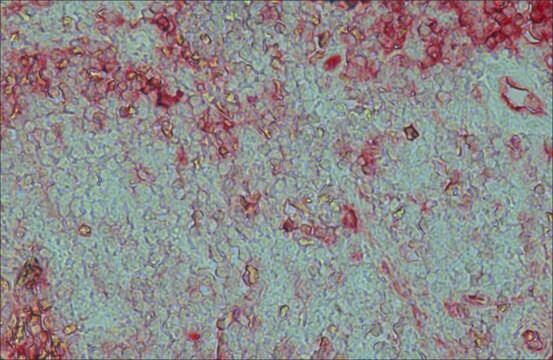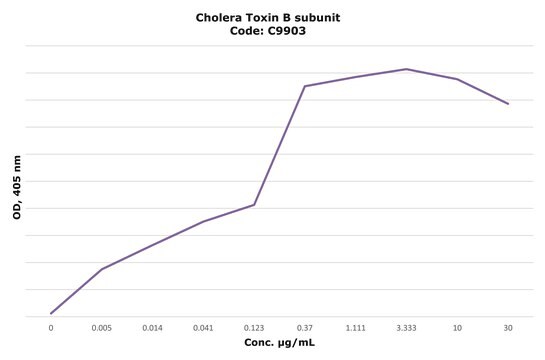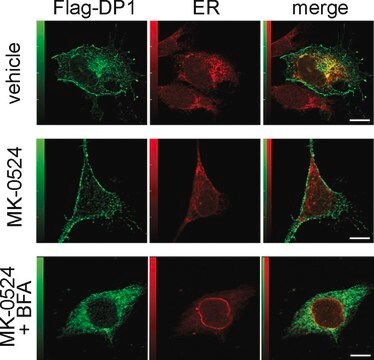227040
Anti-Cholera Toxin, B-Subunit Goat pAb
lyophilized, Calbiochem®
Synonym(s):
Anti-Cholera Antibody, Cholera Toxin Detection, Goat Anti-Cholera Toxin
Sign Into View Organizational & Contract Pricing
All Photos(1)
About This Item
UNSPSC Code:
12352203
NACRES:
NA.43
Recommended Products
biological source
goat
Quality Level
antibody form
serum
antibody product type
primary antibodies
clone
polyclonal
form
lyophilized
contains
≤0.1% sodium azide as preservative
manufacturer/tradename
Calbiochem®
storage condition
OK to freeze
isotype
IgG
shipped in
ambient
storage temp.
2-8°C
target post-translational modification
unmodified
General description
Goat polyclonal antibody supplied as lyophilized undiluted serum. Recognizes cholera toxin B-subunit.
Recognizes the B-subunit of cholera toxin.
This Anti-Cholera Toxin, B-Subunit Goat pAb is validated for use in Immunoblotting, Frozen Sections, Immunocytochemistry, ELISA for the detection of Cholera Toxin, B-Subunit.
Immunogen
Vibrio cholerae
non-denatured Cholera Toxin, B-subunit
Application
Immunoblotting (see application references)
Frozen Sections (1:4000; see application references)
Immunocytochemistry (1:200; see application references)
ELISA (1:10,000; see application references)
Frozen Sections (1:4000; see application references)
Immunocytochemistry (1:200; see application references)
ELISA (1:10,000; see application references)
Warning
Toxicity: Standard Handling (A)
Physical form
Undiluted serum.
Reconstitution
Reconstitute in 100 µl dH₂O. Further dilute with aqueous buffers, such as PBS.
Other Notes
Antibody should be titrated for optimal results in individual systems.
Vadolas, J., et al. 1995. Eur. J. Immunol. 25, 969.
Craig, J.P. 1971. Microbial Toxins 2A, 189.
Selected Citations
Peters, I., et al. 2009. Biochim. Biophys. Acta1788, 964.
Balasubramanian, N., et al. 2007. Nature Cell Biology9, 1381.
Nemchinov, L.G., Et al. 2000. Arch. Virol.145, 2557.
Craig, J.P. 1971. Microbial Toxins 2A, 189.
Selected Citations
Peters, I., et al. 2009. Biochim. Biophys. Acta1788, 964.
Balasubramanian, N., et al. 2007. Nature Cell Biology9, 1381.
Nemchinov, L.G., Et al. 2000. Arch. Virol.145, 2557.
Legal Information
CALBIOCHEM is a registered trademark of Merck KGaA, Darmstadt, Germany
Not finding the right product?
Try our Product Selector Tool.
Storage Class Code
11 - Combustible Solids
WGK
WGK 1
Certificates of Analysis (COA)
Search for Certificates of Analysis (COA) by entering the products Lot/Batch Number. Lot and Batch Numbers can be found on a product’s label following the words ‘Lot’ or ‘Batch’.
Already Own This Product?
Find documentation for the products that you have recently purchased in the Document Library.
Jing Du et al.
Cerebrospinal fluid research, 6, 3-3 (2009-03-19)
It has been shown that distal cerebrospinal fluid-contacting neurons (dCSF-CNs) exist near the ventral midline of the midbrain aqueduct and also in the grey matter of the inferior third ventricle and the fourth ventricle floor in the superior segment of
Jeffrey Hubbard et al.
Proceedings of the National Academy of Sciences of the United States of America, 118(25) (2021-06-23)
Artificial lighting, day-length changes, shift work, and transmeridian travel all lead to sleep-wake disturbances. The nychthemeral sleep-wake cycle (SWc) is known to be controlled by output from the central circadian clock in the suprachiasmatic nuclei (SCN), which is entrained to
Nagaraj Balasubramanian et al.
Nature cell biology, 9(12), 1381-1391 (2007-11-21)
Integrin-mediated adhesion regulates membrane binding sites for Rac1 within lipid rafts. Detachment of cells from the substratum triggers the clearance of rafts from the plasma membrane through caveolin-dependent internalization. The small GTPase Arf6 and microtubules also regulate Rac-dependent cell spreading
L G Nemchinov et al.
Archives of virology, 145(12), 2557-2573 (2001-02-24)
Hepatitis C virus (HCV) is a major cause of acute and chronic hepatitis with over 180 million cases worldwide. Vaccine development for HCV has been difficult. Presently, the virus cannot be grown in tissue culture and there is no vaccine
J Müthing et al.
Glycoconjugate journal, 14(1), 19-28 (1997-01-01)
In this study the comparative TLC immunostaining investigation of neutral GSLs and gangliosides from human skeletal and heart muscle is described. A panel of specific polyclonal and monoclonal antibodies as well as the GM1-specific choleragenoid were used for the overlay
Our team of scientists has experience in all areas of research including Life Science, Material Science, Chemical Synthesis, Chromatography, Analytical and many others.
Contact Technical Service








